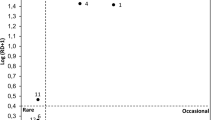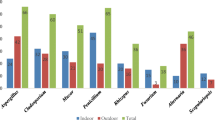Summary
A survey of the incidence of air-borne fungi in Sydney was carried out for one year by daily exposure of Petri plates containing Sabouraud's medium. A total of 3893 colonies were counted.
The fungi most commonly grown wereCladosporium, Alternaria andEpicoccum; these accounted for 51.9% of all colonies.
An attempt was made to correlate the work with the average daily mean temperature, the relative humidity and the number of rainy days. No clear correlation could be established between colony counts and wind direction and velocity.
Zusammenfassung
Eine Untersuchung über das Vorkommen von durch die Luft getragenen Pilzen in Sydney wurde während eines Jahres durch tägliche Ausstellung von Petri-Schalen mit Sabouraud's Nährmedium durchgeführt. Insgesamt sind 3893 Kolonien gezählt worden.
Die am häufigsten gefundenen Pilze waren:Cladosporium, Alternaria undEpicoccum; sie umfassten 51.9% aller Kolonien.
Ein Versuch wurde unternommen, um diese Befunde mit der durchschnittlichen, täglichen Mitteltemperatur, der relativen Feuchtigkeit und mit der Zahl der Regentage in Korrelation zu bringen. Keine klare Korrelation konnte zwischen Kolonie-Zahl, Windrichtung und Windgeschwindigkeit festgestellt werden.
Similar content being viewed by others
References
Feinberg, S. M.: Allergy in practice, pp. 1–838. Chicago. Allergy to fungi, pp. 216–84 (1947).
Hyde, H. A. &Williams, D. A.: A census of mould spores in the atmosphere. Nature, Lond.164 668–9 (1949).
Ainsworth, G. C.: The incidence of air-borne Cladosporium spores in the London region. J. gen. Microbiol.7 358–361 (1952).
Di Menna, M. E.: A quantitative survey of aerial moulds and yeast in Dunedin, New Zealand. Trans. Brit. Myc. Soc.38 119 (1955).
Dye, M. H. &Vernon, T. R.: Air-borne mould spores. A New Zealand survey. N.Z.J. Sci. Tech. B.34 118 (1952).
Durham, O. C.: An unusual shower of fungus spores. J. Amer. med. Ass.111 24–5 (1938).
Targow, A. M. &Plunkett, O. A.: Incidence of Atmospheric Spores in the Los Angeles Area. Ann. Allergy,9 428–445 (1951).
Harsh, G. F. &Allen, S. E.: A study of the fungus contaminants of the air of San Diego and vicinity. J. Allergy,16 125, (1945).
Hyde, H. A. &Williams, D. A.: The incidence of Cladosporium herbarum in the outdoor air at Cardiff, 1949–50. Trans. Brit. Myc. Soc.36 260 (1953).
Morrow, M. B.: Mould fungi in the etiology of respiratory allergic diseases. VII. Further survey studies. Ann. Allergy,5 442 (1947).
Lacaz, C. S., Mendez, E., Pinto, R. Y. D., Cardoso, T. H. B., Lucchetti, L. C. H.: Fungos anemofilos mas cidaded de Sao Paulo e Santos (Brasil) Rev. Hosp. Clin.13 187–193 (1958)
Additional information
Working with the help of a full time grant from the National Health and Medical Research Council of Australia.
Rights and permissions
About this article
Cite this article
Frey, D., Durie, E.B. The incidence of air-borne fungus in Sydney. Mycopathologia et Mycologia Applicata 13, 93–99 (1960). https://doi.org/10.1007/BF02155505
Issue Date:
DOI: https://doi.org/10.1007/BF02155505




